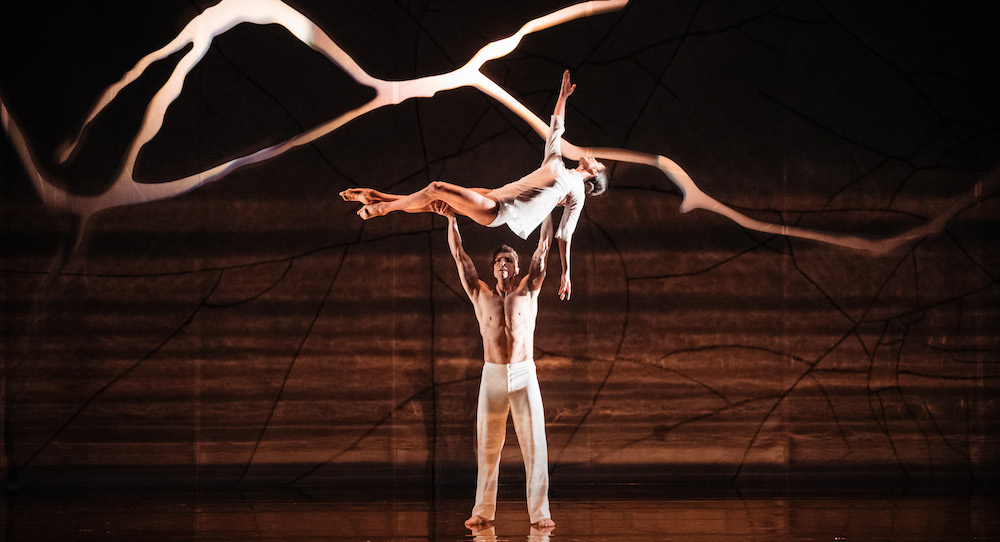Sydney Opera House, Sydney.
5 April 2019.
Verve gives Sydney a triple dose of contemporary ballet. All three works by The Australian Ballet featured home grown talent, all of whom have cut their choreographic wings within the company itself. This season highlights works by seasoned creatives Stephen Baynes and Tim Harbour with the company’s current resident choreographer, Alice Topp. The evening of ballet presented truly showed how vast the genre of contemporary ballet is, each work distinctively unique from one another and clearly stamped by each of their creators.

Stephen Baynes’s ‘Constant Variants’. Photo by Daniel Boud.
Constant Variants by Stephen Baynes opened the show. The work has flirtation with the composer’s original musical intentions, set to Tchaikovsky’s “Variations on a Rococo Theme”. There was classic homage to theme and variation, canon and repetition used like the right amount of salt, coloured with beautiful line and shape. What stood out from the choreographic constructs were the dynamic use of lifts, highlighted even more so with the lightning design by Jon Buswell.
Somewhat of the rose between two quite beautiful thorns in this triple bill is the company’s current female injection to new original Australian is Alice Topp. She is a gift! Aurum is a very thought out and complete idea, presented with such precise detail. The work is reflective of the Japanese art form that gives new life to broken pottery/ceramics. The art form uses gold to restore the broken pieces into a new form much more beautiful than its original one. It also reflects the parallel of the beauty of humanity’s brokenness and vulnerabilities to the aurum artwork. One quote that gave life to Topp’s work is from Ernest Hemingway: “The world breaks everyone, and afterward many are strong at the broken places.” It been a long time since there was a work with so much emotion exuding from the dancers; it is always just dance or the polar opposite, abstract choreography. The only negative in regards to the choreography is there is a beautiful climax in the music in the first section, and the movement of the ensemble was simple, almost playing it very safe and very slow in comparison. It felt like all the movement needed to be performed in double time and visually needed to be more complex, both in movement and with special patterns. However, Topp took huge risks with the staging and set design — the flooring becoming the backdrop and then more flooring that was metallic were ground-breaking additions that really completed the creative concept.

The Australian Ballet in Alice Topp’s ‘Aurum’. Photo by Daniel Boud.
In the beginning, the female dancers wore ankle-high white socks. For the audience member, this was not aesthetically pleasing and destroyed the leg lines, becoming somewhat distracting. It became obvious with the flooring/set change that the socks were a necessary choice, but flesh-coloured socks would have been far more visually pleasing. The male dancers were dressed in white pants, a little too reminiscent of cricket pants. Their attire needed more softness to it to accompany the emotion the dancers were giving. Topp has created a work that Australia should be proud to export overseas, and it will soon hit the stage in New York. As Australians, we can only hope that we can see her receive critical acclaim in the USA.

The Australian Ballet in Tim Harbour’s ‘Filigree and Shadow’. Photo by Daniel Boud.
Tim Harbour’s abstract choreography, Filigree and Shadow, closed the evening — full of high energy and constantly changing movement. The set immediately removed it from the traditional, even in the contemporary ballet sense. The set had half cylindrical shape to it and was set to the back of the stage. This created just two entrances on and off the stage, and the dancers’ entrances and exits did mimic the eye of the hurricane. Harbour’s process partially linked to birds surviving a hurricane, the movement revolving around these shapes created on the stage. Intricate balletic steps mixed with more contemporary floor work, showed both the dancers’ strengths and weaknesses. The fast and dynamic steps highlighted made some dancers stand out more than others. Much of the floor work exposed the dancers’ lack of more true contemporary way of moving in and out of the floor. Throughout the choreography, it felt that most of them were not grounded in their plié into the floor enough. If the dancers can tap into this more, it will take this work to the next level. Throughout the piece, I was left feeling like the dancers were dancing “safe”, whereas the set and lightning design created a space that was open to so much more.
Ballet and contemporary lovers will easily find something to enjoy in The Australian Ballet’s latest triple bill. There is something for everybody. Let’s hope they keep bringing exciting new works to our stages across the country.
By Dolce Fisher of Dance Informa.

















